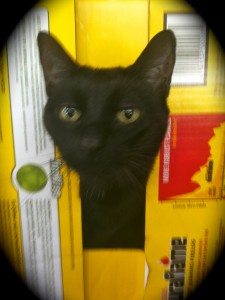
Genevieve Valentine: Though your stories take place in different worlds and range from the comic to the tragic, a common theme is the intrusion of the fantastic into the everyday (for certain values of “everyday”); do you find it more satisfying, as a reader, when there is conflict between worlds, or cooperation?
Cat Rambo: Well – story inevitably comes about as a result of conflict. Where there is only cooperation, as nice as it sounds, stories become a lot subtler and dreamier and sometimes easy to miss.
To me one of the inevitable things about the intrusion of the fantastic is that it makes us rethink the everyday in a way that may provoke a similar conflict in our souls. The very best stories sock us in the gut and leave us gasping with realization that we almost missed a cathartic moment.
GV: The workshopping process seems close to your heart; in what ways do you feel it’s shaped you as a writer and as a reader? What is your advice for writers who want to find, our found, a writers’ group?
CR: Curiously, I’ve found myself listening less and less to the line by line comments and more to the broad-scale, big-picture level stuff. If I can infuriate my friend Derek Zumsteg, I know I’ve gone far.
It’s possible to get too carried away with workshopping, to end up pulled in too many directions by too many voices. As far as founding a group goes – make sure everyone is at a comparable level, that people communicate with trust and respect, and that you establish the ground rules early on.
GV: Your stories are steeped in folklore, but your retellings seem built on the barest bones of the original tale. What advice would you give for writers who want to make an old fairy tale new again?
CR: When I was a kid, I was working with a somewhat limited library. I ran out of fiction to read, in fact, and they wouldn’t let kids 13 or below check out books from the adult stacks. So I spent a few months one summer working my way through the fairy tale and folklore section, which is where all the bones of fairytales that come glimmering through in my stories, such as “Heart in a Box” or “A Key Decides Its Destiny”, grow from.
It’s hard to do anything new with fairytales anymore because the top layer has been mined so thoroughly. If I’d seen the wealth of mermaid stories that I’ve seen since taking on reading for Fantasy Magazine, I don’t know that I would have been arrogant enough to try a new take on the Little Mermaid or Dick Wellington’s Cat (The Dead Girl’s Wedding March).
GV: What was the particular fact or piece of trivia that determined your course in writing “The Towering Monarch of His Race”?
CR: I was writing an encyclopedia entry on the acquisition of Jumbo the elephant by P.T. Barnum and the story’s details were too good not to go into a story. They are, for the most part, true — Jumbo did die as a result of a collision with a train and it’s true that when Barnum was told that Jumbo had laid down and refused to board the ship to America, he said every day the elephant spent lying down was priceless in terms of publicity. The elephant did refuse to go aboard until his keeper coaxed him onto it, and all of England mourned the elephant’s departure.
GV: Animals make frequent appearances in your stories; what are the challenges of writing around (and sometimes, writing as) an animal?
CR: Well, I have never found this quite as radical an act as some readers seem to have thought it. I know I caught some flak about writing from an elephant’s pov part of the time in The Towering Monarch of His Race, but I didn’t think it too over the top. I researched it and I spent time thinking about what an elephant would notice.
GV: So, what’s your beef with eagles?
CR: I like eagles! I see both golden and bald eagles almost every morning when I go to get my coffee – we have a tree down near the water that they’re nesting in.
GV: What’s something you feel people overlook in your writing?
CR: The muscular nature of my sentences, which I try to pare down as much as possible.
GV: What about your writing makes you roll your eyes sometimes?
CR: Often I get carried away with the intense beauty of my prose.
GV: As an [Overlord for Armageddon, you came to the table well aware of the potential and the peril of an online identity. What online platforms have been of most benefit to you as a writer? What should new writers avoid?
CR: I was, and still am, an Overlord for Armageddon, which is a game I’ve worked with for almost two decades now. I have been a public figure in the game for most of that time, and find being a writer/editor not much different. People are generally kind and patient if you are patient and kind with them, but you should also not be a pushover.
Computers are TERRIBLE TIME SUCKS but sort of unavoidable. Avoid committing too much of your time to an online presence – it does you no good if you don’t have some actual writing to sell.
GV: You’re doing a DIY promotional tour for Eyes Like”¦. In an age where publishing is getting scaled back, writers are becoming their own best publicists. What have you discovered about self-promotion while preparing for this tour? What are you looking forward to? What’s the number one mistake you’re afraid of making?
CR: That it’s incredibly hard, tedious work. I’ve been going through my mail compiling a list of reviewers and bloggers, for example, that I want to make sure get an ARC (advance reading copy of the book). I’m preparing for a 31 day virtual blog tour, as well as a month on the road where I’ll be reading at the KGB bar in NYC as well as venues in Philadelphia, Indiana, Kansas, Colorado, Salt Lake City, and Seattle.
In this I’ve been happy to have my retired mother compiling a lot of the info as well as my incredibly talented friend Kris doing a lot of the graphic work.
I am worried about pushing too hard with this book and alienating people, but at the same time, I’m learning that unless you ask, you can’t find out, sometimes.
GV: The most frustrating part of the writing process is _________.
CR: The slowness. I can’t stand markets that take 6+ months to reply. I think that’s RIDICULOUS. At Fantasy we turn stuff around within a week tops, and that’s processing 400-500 fiction pieces a month. :p
GV: This can be solved by _________ and liberal applications of _________.
CR: Determination and weed.





